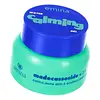What's inside
What's inside
 Key Ingredients
Key Ingredients

 Benefits
Benefits

 Concerns
Concerns

No concerns
 Ingredients Side-by-side
Ingredients Side-by-side

Water
Skin ConditioningPanthenol
Skin ConditioningButylene Glycol
HumectantGlycerin
HumectantSaccharide Isomerate
HumectantCodium Tomentosum Extract
Skin ProtectingSea Water
HumectantSodium Hyaluronate
HumectantPhenoxyethanol
PreservativeCarbomer
Emulsion StabilisingCentella Asiatica Leaf Extract
Skin ConditioningPropanediol
SolventAllantoin
Skin ConditioningTriethanolamine
BufferingDisodium EDTA
Bis-PEG-15 Methyl Ether Dimethicone
EmulsifyingPentylene Glycol
Skin ConditioningLactobacillus/Collagen/Mesembryanthemum Crystallinum Leaf Extract Ferment Lysate
Skin ConditioningCitric Acid
BufferingSodium Citrate
BufferingPolyglutamic Acid
Skin ConditioningHydrolyzed Hyaluronic Acid
HumectantGlyceryl Acrylate/Acrylic Acid Copolymer
Humectant1,2-Hexanediol
Skin ConditioningPvm/Ma Copolymer
Emulsion StabilisingHydroxypropyltrimonium Hyaluronate
Ethylhexylglycerin
Skin ConditioningSodium Acetylated Hyaluronate
HumectantWater, Panthenol, Butylene Glycol, Glycerin, Saccharide Isomerate, Codium Tomentosum Extract, Sea Water, Sodium Hyaluronate, Phenoxyethanol, Carbomer, Centella Asiatica Leaf Extract, Propanediol, Allantoin, Triethanolamine, Disodium EDTA, Bis-PEG-15 Methyl Ether Dimethicone, Pentylene Glycol, Lactobacillus/Collagen/Mesembryanthemum Crystallinum Leaf Extract Ferment Lysate, Citric Acid, Sodium Citrate, Polyglutamic Acid, Hydrolyzed Hyaluronic Acid, Glyceryl Acrylate/Acrylic Acid Copolymer, 1,2-Hexanediol, Pvm/Ma Copolymer, Hydroxypropyltrimonium Hyaluronate, Ethylhexylglycerin, Sodium Acetylated Hyaluronate
Water
Skin ConditioningNiacinamide
SmoothingDipropylene Glycol
HumectantButylene Glycol
HumectantPropanediol
SolventCarbomer
Emulsion Stabilising1,2-Hexanediol
Skin ConditioningAllantoin
Skin ConditioningPanthenol
Skin ConditioningAminomethyl Propanol
BufferingAmmonium Acryloyldimethyltaurate/Vp Copolymer
Chlorphenesin
AntimicrobialBiosaccharide Gum-2
Skin ConditioningCaprylhydroxamic Acid
Disodium EDTA
Centella Asiatica Extract
CleansingPhenoxyethanol
PreservativeMadecassoside
AntioxidantPEG-8
HumectantPentylene Glycol
Skin ConditioningBeta-Glucan
Skin ConditioningSalicylic Acid
MaskingCaprylyl Glycol
EmollientIsostearamidopropyl Ethyldimonium Ethosulfate
Sodium Hydroxide
BufferingPropylene Glycol
HumectantCarthamus Tinctorius Seed Oil
MaskingOlea Europaea Fruit Oil
MaskingWater, Niacinamide, Dipropylene Glycol, Butylene Glycol, Propanediol, Carbomer, 1,2-Hexanediol, Allantoin, Panthenol, Aminomethyl Propanol, Ammonium Acryloyldimethyltaurate/Vp Copolymer, Chlorphenesin, Biosaccharide Gum-2, Caprylhydroxamic Acid, Disodium EDTA, Centella Asiatica Extract, Phenoxyethanol, Madecassoside, PEG-8, Pentylene Glycol, Beta-Glucan, Salicylic Acid, Caprylyl Glycol, Isostearamidopropyl Ethyldimonium Ethosulfate, Sodium Hydroxide, Propylene Glycol, Carthamus Tinctorius Seed Oil, Olea Europaea Fruit Oil
 Reviews
Reviews

Ingredients Explained
These ingredients are found in both products.
Ingredients higher up in an ingredient list are typically present in a larger amount.
1,2-Hexanediol is a synthetic liquid and another multi-functional powerhouse.
It is a:
- Humectant, drawing moisture into the skin
- Emollient, helping to soften skin
- Solvent, dispersing and stabilizing formulas
- Preservative booster, enhancing the antimicrobial activity of other preservatives
Allantoin is a soothing ingredient known for its protective and moisturizingg properties. Because of this, it is often added to products with strong active ingredients.
Studies show higher concentrations of this ingredient can promote wound healing.
Though it can be derived from the comfrey plant, allantoin is produced synthetically for cosmetic products to ensure purity.
Learn more about AllantoinButylene Glycol (or BG) is used within cosmetic products for a few different reasons:
Overall, Butylene Glycol is a safe and well-rounded ingredient that works well with other ingredients.
Though this ingredient works well with most skin types, some people with sensitive skin may experience a reaction such as allergic rashes, closed comedones, or itchiness.
Learn more about Butylene GlycolCarbomer is a polymer of acrylic acid. Its main role is to create a gel consistency.
A high amount of carbomer can cause pilling or balling up of products. Don't worry, most products contain 1% or less of carbomer.
Disodium EDTA plays a role in making products more stable by aiding other preservatives.
It is a chelating agent, meaning it neutralizes metal ions that may be found in a product.
Disodium EDTA is a salt of edetic acid and is found to be safe in cosmetic ingredients.
Learn more about Disodium EDTAPanthenol is a common ingredient that helps hydrate and soothe the skin. It is found naturally in our skin and hair.
There are two forms of panthenol: D and L.
D-panthenol is also known as dexpanthenol. Most cosmetics use dexpanthenol or a mixture of D and L-panthenol.
Panthenol is famous due to its ability to go deeper into the skin's layers. Using this ingredient has numerous pros (and no cons):
Like hyaluronic acid, panthenol is a humectant. Humectants are able to bind and hold large amounts of water to keep skin hydrated.
This ingredient works well for wound healing. It works by increasing tissue in the wound and helps close open wounds.
Once oxidized, panthenol converts to pantothenic acid. Panthothenic acid is found in all living cells.
This ingredient is also referred to as pro-vitamin B5.
Learn more about PanthenolPentylene glycol is typically used within a product to thicken it. It also adds a smooth, soft, and moisturizing feel to the product. It is naturally found in plants such as sugar beets.
The hydrophilic trait of Pentylene Glycol makes it a humectant. As a humectant, Pentylene Glycol helps draw moisture from the air to your skin. This can help keep your skin hydrated.
This property also makes Pentylene Glycol a great texture enhancer. It can also help thicken or stabilize a product.
Pentylene Glycol also acts as a mild preservative and helps to keep a product microbe-free.
Some people may experience mild eye and skin irritation from Pentylene Glycol. We always recommend speaking with a professional about using this ingredient in your routine.
Pentylene Glycol has a low molecular weight and is part of the 1,2-glycol family.
Learn more about Pentylene GlycolPhenoxyethanol is a preservative that has germicide, antimicrobial, and aromatic properties. Studies show that phenoxyethanol can prevent microbial growth. By itself, it has a scent that is similar to that of a rose.
It's often used in formulations along with Caprylyl Glycol to preserve the shelf life of products.
Propanediol is an all-star ingredient. It softens, hydrates, and smooths the skin.
It’s often used to:
Propanediol is not likely to cause sensitivity and considered safe to use. It is derived from corn or petroleum with a clear color and no scent.
Learn more about PropanediolWater. It's the most common cosmetic ingredient of all. You'll usually see it at the top of ingredient lists, meaning that it makes up the largest part of the product.
So why is it so popular? Water most often acts as a solvent - this means that it helps dissolve other ingredients into the formulation.
You'll also recognize water as that liquid we all need to stay alive. If you see this, drink a glass of water. Stay hydrated!
Learn more about Water